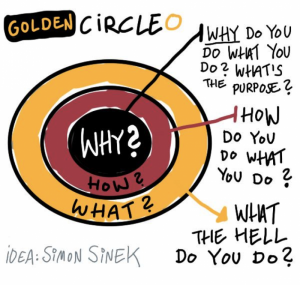Why you do it
In the previous article we talked about how to find the right creative job and who you are, but do you know why you do it? Many of you who have undertaken prestigious studies fail to achieve the desired results, but this depends on many factors: one of them is to ask why or rather the “reason why” you are trying to take one path rather than another.
Simon Sinek reminds us that people are driven by why you do something and not by “what” you do:
• Why did you choose that pattern over another one?
• Why did you decide to use the colour orange in your portfolio for your latest campaign for children with cardiovascular diseases?
• Why do you think design can change the world?
• Why do you think good user experience is important?
• Why are light and well-made websites important?
If you can find the reason why you will be able to enhance your personality and you can have a more satisfying job and life: you will start thinking about something bigger than yourself and you will feel an eternal passion for your work that will stimulate you to achieve ever higher goals.
You have to focus and think about what drives you to move forward: you will identify an ideal and a value that you believe in deeply and that will be useful for you and above all others.
You don’t have to be a leader, manager or entrepreneur to understand what makes you feel really alive, motivated and realized.
Once you have found your why, others will inevitably be fascinated and attracted to you.
Simon Sinek talked about these issues in his book “Start with why” which is useful for everyone and not just for company managers.
The three most important things in his book are listed here:
1. The difference between succeeding and feeling realized
If someone asked you, “why are you doing your job?” .
This could make you panic, not because you don’t know how to answer, but because you found yourself in a number of circumstances that that led you to do what you are doing now.
But sometimes it’s good to remember why you do something.
If your reason why is weak, in fact, you risk no one believing it because you yourself do not believe it enough.
To better understand this concept, let’s give you an example: “how do you feel when your partner tells you that they love you? Or when instead they tell you why they love you?”
If they tell you why they love you, this makes you feel more confident about their love for you, and as a result you feel more appreciated.
Remember this example next time they will ask you your “reason why”.
2. The right direction to find your why
Simon Sinek says in his book: “A why is not born by looking forward towards the goal that is intended to be achieved, and trying to devise a suitable strategy to get there. It does not originate from market research. It is not the result of full-time interviews with consumers, let alone with employees. A why comes by looking in the completely opposite direction. Finding out why it is a process of discovery, not of invention. The reason for each individual and every organization always comes from the past. It is the son of the path of growth and experiences of a person or a small group of people”.
Ask yourself what you liked to do when you were little and what made you stay up late in order to finish the activity you were doing.
Above all, always keep in mind the values and the ideals that make you feel good.
3. Beware of the traps you will find along the way
“Being able to see your ‘why’ clearly it’s not the hardest part. The real difficulty is to have the constancy to trust your instincts, to remain true to your purpose, cause or ideal“, Simon Sinek
If you know the reason, you will also be less inclined to give up after the first mistakes and you will be able to keep your results constant.
We also suggest that you take a look at Simon Sinek’s “golden circle” principle.

The golden circle will help you understand the three main moments of any project: starting from why we do something, followed by how and finally what.
For example, job seekers looking for work as designers could develop their own gold circle as follows:
Why: “I believe that design and business communication play a fundamental role in people’s lives. A lot of today’s role models that we see on TV and social media are predominantly focused on physical appearance instead of true values and ideals. As a result, teenagers can be greatly affected. Therefore, designers have a responsibility to help shape a better and more socially responsible world“.
How: “developing advertising campaigns for large companies in the consumer goods sector. In particular for products used by children and adolescents“.
What: “I would like to work in a big agency that has as customers companies in the consumer goods sector”.
Another example might be the following for a young startupper:
Why: “I believe that the entrepreneurial initiatives of young talents who have decided to stay in Italy must be valued above all. Their ability to bring values with them that go beyond mere profit enables them to really listen to people’s suggestions and to not consider them as a purely functional number to meet targets”
How: “having an active role in the development of a small but ambitious initiative”
What: “I would like to work in a social impact startup”
As written before, this articles series were born from Tutelio’s passion and dedication to helping and enhancing creative work.
Learn more about Tutelio and its mission.
* Credits to “fazeducacao” website for the cover image
